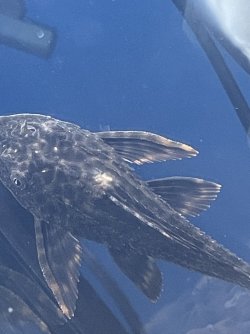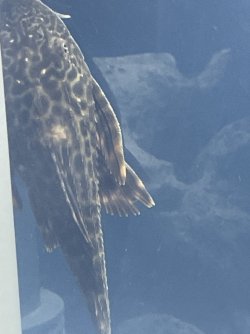You are using an out of date browser. It may not display this or other websites correctly.
You should upgrade or use an alternative browser.
You should upgrade or use an alternative browser.
Possible scrape on pleco
- Thread starter Tl52505
- Start date
DoubleDutch
Fish Gatherer
Looks like a bacterial infection to me.
Any chance of a picture from the side so we can see if it is raised?
If it is a scratch, then big (75%) water changes and gravel cleaning the substrate every day for a week, and cleaning the filter will usually help it heal.
You can add some salt too if you like. Use 1 heaped tablespoon of rock salt for every 20 litres (5 gallons) of tank water. Keep the salt in there for 2 weeks.
If it is a scratch, then big (75%) water changes and gravel cleaning the substrate every day for a week, and cleaning the filter will usually help it heal.
You can add some salt too if you like. Use 1 heaped tablespoon of rock salt for every 20 litres (5 gallons) of tank water. Keep the salt in there for 2 weeks.
Tl52505
Fish Fanatic
It is not raised and the spot is already smaller but still thereAny chance of a picture from the side so we can see if it is raised?
If it is a scratch, then big (75%) water changes and gravel cleaning the substrate every day for a week, and cleaning the filter will usually help it heal.
You can add some salt too if you like. Use 1 heaped tablespoon of rock salt for every 20 litres (5 gallons) of tank water. Keep the salt in there for 2 weeks.
Tl52505
Fish Fanatic
Would they just have that at a local pet storeIt is not raised and the spot is already smaller but still there
Tl52505
Fish Fanatic
Will the salt affect the other fish
Tl52505
Fish Fanatic
And if I’m not able to get the salt, if it is a scrape do you think it would heal naturally
Tl52505
Fish Fanatic
I guess it was nothing because the spot is not there anymore
Tl52505
Fish Fanatic
If you can't get salt, then do a 75% water change and gravel clean the substrate every day for a week or two. The cleaner water will help reduce the number of disease organisms in the water and give the fish more chance of healing.
-------------------
That level of salt (1-2 heaped tablespoons per 20 litres) will not harm fish.
Full directions for using salt are below.
Using Salt to Treat Fish Health Issues.
For some fish diseases you can use salt (sodium chloride) to treat the ailment rather than using a chemical based medication. Salt is relatively safe and is regularly used in the aquaculture industry to treat food fish for diseases. Salt has been successfully used to treat minor fungal and bacterial infections, as well as a number of external protozoan infections. Salt alone will not treat whitespot (Ichthyophthirius) or Velvet (Oodinium) but will treat most other types of protozoan infections in freshwater fishes.
You can add rock salt (often sold as aquarium salt) or swimming pool salt to the aquarium at the dose rate of 1 heaped tablespoon per 20 litres of water. If there is no improvement after 48 hours you can double that dose rate so there is 2 heaped tablespoons of salt per 20 litres.
If you only have livebearers (guppies, platies, swordtails, mollies), goldfish or rainbowfish in the tank you can double that dose rate, so you would add 2 heaped tablespoons per 20 litres and if there is no improvement after 48 hours, then increase it so there is a total of 4 heaped tablespoons of salt per 20 litres.
Keep the salt level like this for at least 2 weeks but no longer than 4 weeks otherwise kidney damage can occur. Kidney damage is more likely to occur in fish from soft water (tetras, Corydoras, angelfish, Bettas & gouramis, loaches) that are exposed to high levels of salt for an extended period of time, and is not an issue with livebearers, rainbowfish or other salt tolerant species.
The salt will not affect the beneficial filter bacteria but the higher dose rate (4 heaped tablespoons per 20 litres) will affect some plants and some snails. The lower dose rate (1-2 heaped tablespoons per 20 litres) will not affect fish, plants, shrimp or snails.
After you use salt and the fish have recovered, you do a 10% water change each day for a week using only fresh water that has been dechlorinated. Then do a 20% water change each day for a week. Then you can do bigger water changes after that. This dilutes the salt out of the tank slowly so it doesn't harm the fish.
If you do water changes while using salt, you need to treat the new water with salt before adding it to the tank. This will keep the salt level stable in the tank and minimise stress on the fish.
When you first add salt, add the salt to a small bucket of tank water and dissolve the salt. Then slowly pour the salt water into the tank near the filter outlet. Add the salt over a couple of minutes.
-------------------
That level of salt (1-2 heaped tablespoons per 20 litres) will not harm fish.
Full directions for using salt are below.
Using Salt to Treat Fish Health Issues.
For some fish diseases you can use salt (sodium chloride) to treat the ailment rather than using a chemical based medication. Salt is relatively safe and is regularly used in the aquaculture industry to treat food fish for diseases. Salt has been successfully used to treat minor fungal and bacterial infections, as well as a number of external protozoan infections. Salt alone will not treat whitespot (Ichthyophthirius) or Velvet (Oodinium) but will treat most other types of protozoan infections in freshwater fishes.
You can add rock salt (often sold as aquarium salt) or swimming pool salt to the aquarium at the dose rate of 1 heaped tablespoon per 20 litres of water. If there is no improvement after 48 hours you can double that dose rate so there is 2 heaped tablespoons of salt per 20 litres.
If you only have livebearers (guppies, platies, swordtails, mollies), goldfish or rainbowfish in the tank you can double that dose rate, so you would add 2 heaped tablespoons per 20 litres and if there is no improvement after 48 hours, then increase it so there is a total of 4 heaped tablespoons of salt per 20 litres.
Keep the salt level like this for at least 2 weeks but no longer than 4 weeks otherwise kidney damage can occur. Kidney damage is more likely to occur in fish from soft water (tetras, Corydoras, angelfish, Bettas & gouramis, loaches) that are exposed to high levels of salt for an extended period of time, and is not an issue with livebearers, rainbowfish or other salt tolerant species.
The salt will not affect the beneficial filter bacteria but the higher dose rate (4 heaped tablespoons per 20 litres) will affect some plants and some snails. The lower dose rate (1-2 heaped tablespoons per 20 litres) will not affect fish, plants, shrimp or snails.
After you use salt and the fish have recovered, you do a 10% water change each day for a week using only fresh water that has been dechlorinated. Then do a 20% water change each day for a week. Then you can do bigger water changes after that. This dilutes the salt out of the tank slowly so it doesn't harm the fish.
If you do water changes while using salt, you need to treat the new water with salt before adding it to the tank. This will keep the salt level stable in the tank and minimise stress on the fish.
When you first add salt, add the salt to a small bucket of tank water and dissolve the salt. Then slowly pour the salt water into the tank near the filter outlet. Add the salt over a couple of minutes.
Tl52505
Fish Fanatic
Do you think the tear in his fin is fin rot or maybe just scraped it and it ripped
Tl52505
Fish Fanatic
This might sound like I’m crazy but… the tear in his fin is no longer there!? I looked at him this morning and saw the spot where there was a big rip in the fin, no longer there. Is it even possible for that to heal overnight.Do you think the tear in his fin is fin rot or maybe just scraped it and it ripped
Attachments
Similar threads
- Replies
- 0
- Views
- 175
- Replies
- 3
- Views
- 272
- Replies
- 4
- Views
- 243




